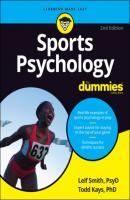Sports Psychology For Dummies. Leif H. Smith
Чтение книги онлайн.

Читать онлайн книгу Sports Psychology For Dummies - Leif H. Smith страница 12
Название: Sports Psychology For Dummies
Автор: Leif H. Smith
Издательство: John Wiley & Sons Limited
Жанр: Спорт, фитнес
isbn: 9781119856016
isbn:
The point we are making here is simply that neither of these athletes took the time to think about, absorb, and celebrate the positive aspects of their performance. This is where having an ideal mindset can help, however. If you do not work on your ideal mindset, you cannot practice it, refine it, or master it. Thus, if you infrequently pay attention to when you perform well and frequently obsess when you do not (usually due to a mistake or two), your default negative mindset will continue, and this is not helpful for performing at your best.
Tapping Into Your Ideal Mindset
The first step is building awareness of what your ideal mindset can be. A good place to start is to make a list of some of your best performances. Speak with your coach, who can help you come up with some of these. Ask your friends, a teammate, or a parent or family member. As you discuss these performances, write them down in a performance journal or verbalize them in a voice notes app on your cell phone. Use the following questions to help jog your brain:
How were you behaving? Smiling, laughing, cheering on teammates, communicating, bouncing back after a mistake?
What were you thinking about? Maybe nothing? Something simple, like “this play” or “breathe” or “be here now?”
What did you experience emotionally? Calmness? Focus? Excitement? Lightness? Ease? Confidence?
What do you notice about your body? Were your muscles tense? Loose? Was your heart rate fast or slow or moderate? Was your breathing quick and shallow or deep, slow, and comfortable?
Once you learn more about your ideal mindset by logging your past great performances, you can begin to practice “re-experiencing” this mindset over and over again with the other tools included in this book. However, if you do not cultivate this mindset ahead of time, you will be simply trying to find the door in a completely dark room.
Discovering your ideal performance mindset
Here are some steps you can take to start learning what your ideal performance mindset is and to utilize it every time you compete.
Start with questions you want to address about past great performances (yesterday or last year, in practice or in competition), and then consider the following advice:
Describe the time and place you were competing. Remember it as vividly as possible, as if you are there, competing, right now.
Describe what made this one of your best performances. Remember that you may not have won the game or the ideal mindset may have only been present for a small time during your game or competition. Some examples might be batting 4 for 4 at the plate, scoring a career high in points, shooting your lowest score in golf, or beating a top-ranked opponent.
Just as you did previously, answer these prompts:Behaviors: Were you smiling, laughing, cheering on teammates, communicating, or bouncing back after a mistake?Thoughts: What were you thinking about? Maybe nothing? Something simple like, “this play” or “breathe” or “be here now?”Emotions: What did you experience emotionally? Calm? Excitement? Lightness? Ease? Confidence?Body: What do you notice about your body? Were your muscles tense or loose? Was your heart rate fast or slow or moderate? Was your breathing short and shallow or easy, deep, and comfortable?
Identify important information by writing in your journal. (Remember: Every athlete should have a performance journal — those who use a journal effectively and consistently get better quicker.) It can be a small journal that you can keep in your athletic bag, but just make it a durable one, as we all know how we toss around our athletic bags. This journal should go with you everywhere.
Journal continuously and consistently each time you have a great performance. You want to key in with specifics and be clear about what exactly was happening during your performance.
Spend time visualizing and burning these performance details into your brain. Read Chapter 7, on imagery, to learn more about how to do this like the pros.
Continue to re-read some of your entries in this journal as a mental training drill from time to time. Remember, if you do not practice your physical skills (for example, your tennis forehand or your free-throws), you won’t improve. By the same token, how can you get better at building your ideal mindset if you don’t practice and perform this simple drill?
Journaling doesn’t need to take a long time. Maybe at times you will decide to enjoy reliving the experience and it will be an incredible and long journal entry that you may refer back to for years, but it also can be a simple jotting down of notes (or bullet points) after a performance. Just remember, the quality of a practice does make a difference (as you know) and, therefore, so does the quality of journaling and mental training. Think about if a field kicker spent their practice time using only about 50 percent of their focus. How would you predict that to work out?
Try to journal as soon after the experience as you can, while the memory is fresh in your brain. You can do this before you leave the locker room or field, or you can journal while on the bus or car ride home. The sooner you do so, the better the details and exact recall of your performance.
Performing without thinking
Personal best performances typically do not involve much thinking, only great physical and mental preparation.
An important awareness point here is that many times when we perform our best, we are not thinking, at least consciously anyway.